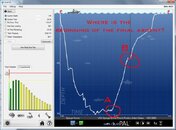...... On that note, could your software do such a thing? (provide a PADI 'PG' from a dive profile?)
Yes of course ..... but, what is the proper "conversion method" of a multilevel dive to a square one?
As you know, several agencies define the bottom time from the beginning of descent to the beginning of the "final ascent". That makes sense for a square profile, but, in a multilevel dive profile, where is the beginning of the final ascent?
As an example, looking at the dive profile below (a real dive on the USS Spiegel Grove) is the beginning of final ascent point A? Or is it point B?

If it is A, then, using average depth, the dive could be approximated to a square dive with a depth of 70ft and a bottom time of 18:06 min, but if it is B, then the "converted" square profile has a depth of 68ft and a bottom time of 24:24min and the related NOAA pressure groups would be E and F respectively.
Or, should we just consider the "square profile" concluded when the diver approaches the safety stop depth? In this case the "converted" square profile would be to a depth of 58ft for 31:31min - corresponding to a pressure group G
So, which one is more correct?
Alberto (aka eDiver)





